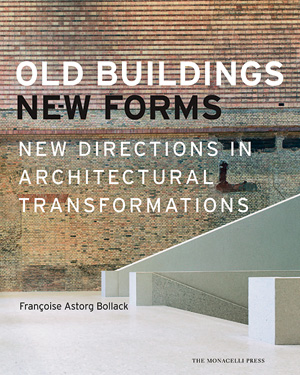Second Lives for Old Structures
Faced with the prospect of the gradual degradation of the buildings that are our architectural heritage, designers need to reconsider their focus on the heroic model of practice, with its emphasis on idiosyncratic form-making and new construction. Instead, they should look to “the creative possibilities of preservation,” says Françoise Bollack. Pursuing these possibilities while celebrating modernity and producing conceptually powerful work is the focus of her book Old Buildings, New Forms. In it, Bollack posits that, “an old building is not an obstacle but rather a foundation for continued action.” The author is a professor at Columbia University and a practicing architect specializing in historic preservation.

Her book groups 28 renovation projects into five types—insertions, parasites, wraps, juxtapositions, and weavings—based on their interactions with the parent structures. Each type is discussed in its historical context, and then the salient features of individual contemporary projects are presented. Some of the projects—David Chipperfield's Neues Museum in Berlin and Miralles-Tagliabue's Santa Caterina Market in Barcelona—will be familiar to readers of architectural record. But many others are modest in scale, done by lesser-known architects like Stefan Eberstadt/Urban Drift Productions and FNP Architeckten. All are emphatically modern.
In her introduction, the author cites Robert Venturi's Complexity and Contradiction in Architecture and the conceptual art of the 1960s and 1970s, particularly that of Sol LeWitt, as crucial elements in the formation of the contemporary renovation strategies represented here. Venturi freed architects from the need to conform to prevailing orthodoxies, and LeWitt stressed the primacy of conceptual expression. The author's introduction is both elegant and illuminating, as are the introductory notes to each of the five types. However, the text's effectiveness begins to diminish in the discussion of the individual projects that forms the core of the book.
At times the project descriptions are poetic; at other times they strain under the weight of an excessively rhetorical style. The photographs, many taken by the author, effectively amplify the text, though the drawings, frequently reductions of working drawings, lack legibility on the page.
The chapter on “parasites,” while featuring an intriguing title, offers an unfortunately erroneous definition of parasitism, which, with every use of the word, spoils the impact of the text for knowledgeable readers. The word that eludes Bollack here is symbiosis.
These quibbles aside, Bollack's book opens readers to the “creative possibilities of preservation.” It gives us a vivid reminder that we can embrace modernity while respecting the past.


Post a comment to this article
Report Abusive Comment